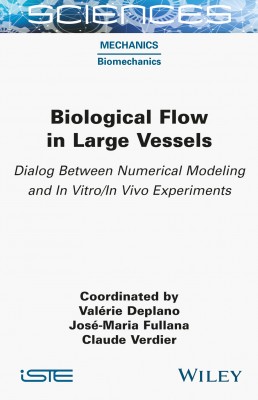
This book examines recent methods used for blood flow modeling and associated in vivo experiments, conducted using experimental data from medical imaging.
Different strategies are proposed, from small-scale models to complex 3D modeling using modern computational codes. The geometries are wide-ranging and deal with the narrowing and widening of sections (stenoses, aneurysms), bifurcations, geometries associated with prosthetic elements, and even cases of vessels with smaller dimensions than those of the blood cells circulating in them.
Biological Flow in Large Vessels provides answers to the question of how medical and biomechanical knowledge can be combined to address clinical problems. It offers guidance for further development of numerical models, as well as experimental protocols applied to clinical research, with tools that can be used in real-time and at the patient’s bedside, for decision-making support, predicting the progression of pathologies, and planning personalized interventions.
1. Hemodynamics and Hemorheology, Thomas Podgorski.
2. CFD Analyses of Different Parameters Influencing the Hemodynamic Outcomes of Complex Aortic Endovascular Repair, Sabrina Ben-Ahmed, Jean-Noël Albertini, Jean-Pierre Favre, C. Alberto Figueroa, Eugenio Rosset, Francesca Condemi and Stéphane Avril.
3. Vascular Geometric Singularities, Hemodynamic Markers and Pathologies, Valérie Deplano and Carine Guivier-Curien.
4. Role of Arterial Blood Flow in Atherosclerosis, Guillermo Vilplana and Abdul I. Barakat.
5. Patient-specific Hemodynamic Simulations: Model Parameterization from Clinical Data to Enable Intervention Planning, Irene E. Vignon-Clementel and Sanjay Pant.
6. Reduced-order Models of Blood Flow: Application to Arterial Stenoses, Jeanne Ventre, José-Maria Fullana, Pierre-Yves Lagrée,
Francesca Raimondi and Nathalie Boddaert.
7. YALES2BIO: A General Purpose Solver Dedicated to Blood Flows, Simon Mendez, Alain Bérod, Christophe Chnafa, Morgane Garreau, Etienne Gibaud, Anthony Larroque, Stephanie Lindsey, Marco Martins Afonso, Pascal Mattéoli, Rodrigo Mendez Rojano, Dorian Midou, Thomas Puiseux, Julien Sigüenza, Pierre Taraconat, Vladeta Zmijanovic and Franck Nicoud.
8. Capsule Relaxation Under Flow in a Tube, Bruno Sarkis, Anne-Virginie Salsac and José-Maria Fullana.
Valérie Deplano is research director at CNRS, and an active member of the CNRS research group MECABIO, GDR3570, dealing with the mechanics of materials and biological fluids. She is the former head of the GDR2760 research group, focusing on the biomechanics of fluids and transfers, fluid-biological structure interaction, and President of the Biomechanics Society 2018–2021.
José-Maria Fullana is a professor at Sorbonne University, Paris, and an active member of the CNRS research group MECABIO, GDR3570, dealing with the mechanics of materials and biological fluids.
Claude Verdier is research director at CNRS, and an active member of the CNRS research group GDR3570, MECABIO, dealing with the mechanics of materials and biological fluids. He is the former leader of the GDR3570 research group.